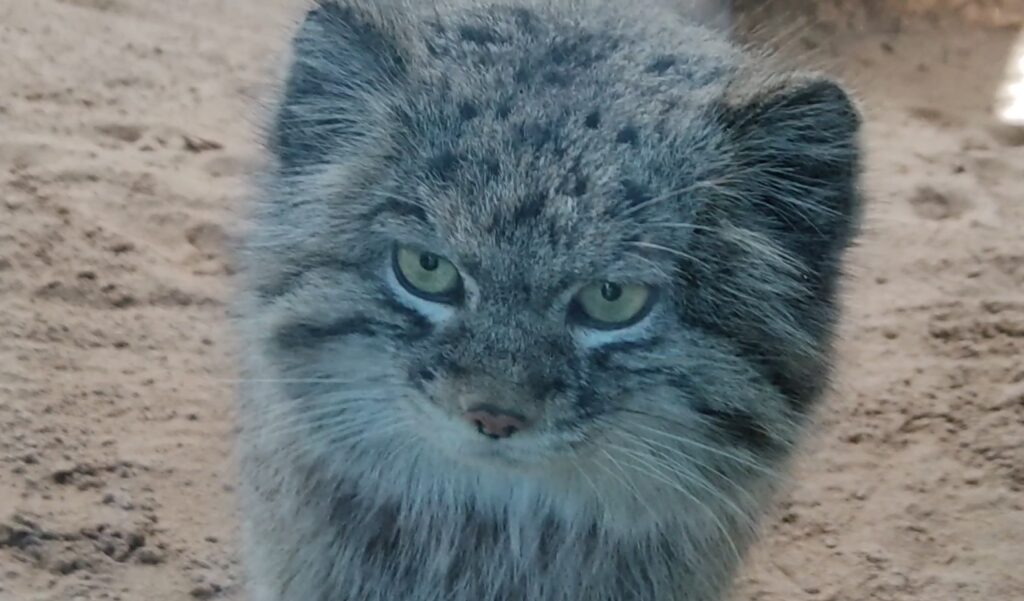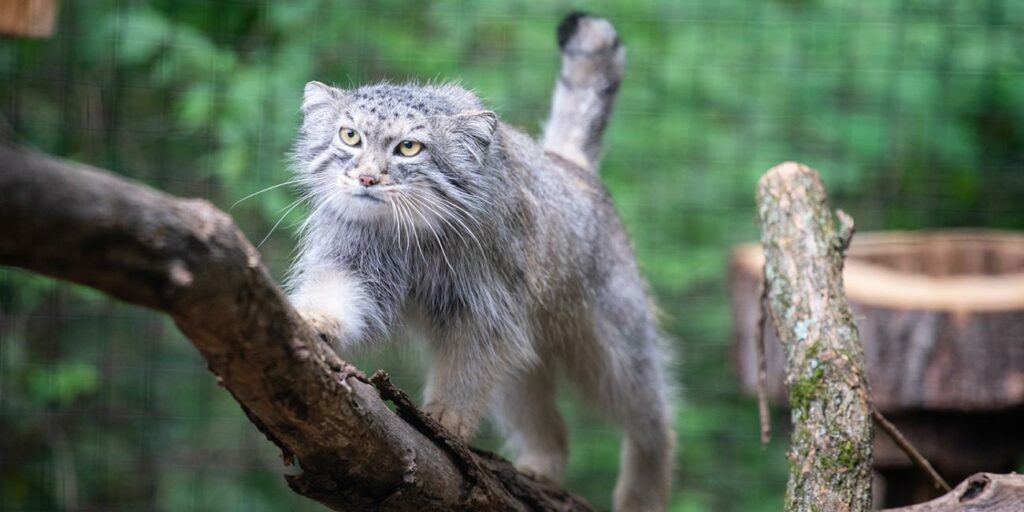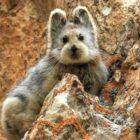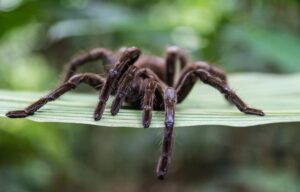Are Pallas Cats grumpy?

Pallas Cats, scientifically known as Otocolobus manul, are enigmatic creatures inhabiting the rugged landscapes of Central Asia. Despite their relatively small size, these felines possess a distinct appearance that sets them apart from other wild cats.
Pallas Cat Live in Harsh Environments
Pallas Cats, also known as Manuls, primarily inhabit the rugged and inhospitable landscapes of Central Asia. They are found in various countries across this region, including Mongolia, Russia, China, Pakistan, Afghanistan, Kazakhstan, Kyrgyzstan, Tajikistan, and Uzbekistan. These areas are characterized by high altitudes, rocky terrain, sparse vegetation, and extreme temperature fluctuations, ranging from scorching summers to freezing winters.
Within these habitats, Pallas Cats are adaptable to a variety of environments, including grasslands, steppes, deserts, and mountainous regions. They often choose locations with rocky outcrops, crevices, and burrows that provide shelter and camouflage against predators.
Nocturnal Lifestyle
Pallas Cats are primarily nocturnal, meaning they are most active during the night. This behavior is a strategic adaptation to their environment, where daytime temperatures can be extreme, ranging from scorching heat to freezing cold depending on the season and location. By avoiding the heat of the day and hunting under the cover of darkness, Pallas Cats conserve energy and increase their chances of successful prey capture.
Their nocturnal habits also serve as a form of protection against potential predators. Many larger carnivores, such as wolves and eagles, are more active during the day, reducing the risk of encounters with Pallas Cats during their nighttime forays.
Solitary Lifestyle
Pallas Cats are solitary animals, typically maintaining exclusive territories that they defend against intruders of the same species. These territories vary in size depending on factors such as food availability and population density. Within their territories, Pallas Cats establish scent markings using urine and secretions from scent glands located on their faces and paws. These markings serve as a means of communication, signaling to other Pallas Cats about their presence and territorial boundaries.
Their solitary lifestyle also extends to their hunting behavior. Unlike social predators such as lions, Pallas Cats rely on their individual hunting skills to capture prey. Their diet mainly consists of small mammals like pikas, voles, and gerbils, which they stalk and ambush with precision.
Thick Fur
The fur of a Pallas’s cat can be described as remarkably thick and dense. The underfur, which is the shorter and softer layer of fur closest to the skin, measures approximately 40 mm (1.6 in) in length and 19 μm in thickness. In contrast, the guard hairs, which are longer and coarser, can reach lengths of up to 69 mm (2.7 in) and have a thickness of 93 μm on the back of the cat.
This combination of underfur and guard hairs contributes to the overall plushness and insulation provided by the Pallas’s cat’s fur coat. The underfur acts as a soft, insulating layer to trap heat close to the body, while the longer guard hairs help protect against moisture and provide additional warmth.
Additionally, the fur is described as soft and dense, with up to 9,000 hairs per square centimeter (58,000 hairs per square inch). This high hair density further enhances the fur’s ability to retain heat and protect the cat from the harsh climates of its native habitat.
Pallas Cats Are Not Very Social
Pallas Cats are not very social, but possess a sophisticated system of communication that includes vocalizations, body language, and scent marking.
Hisses, Growls, or Purrs
While Pallas Cats are generally quiet animals, they do use vocalizations to convey certain messages. They may emit hisses, growls, or purrs, each of which serves a specific purpose. Hissing is often a defensive response when they feel threatened or alarmed. Growling can indicate aggression or discomfort, especially during territorial disputes or mating encounters. Purring, on the other hand, is associated with relaxation and contentment, commonly heard during moments of rest or after a successful hunt.
Body Language
Pallas Cats are adept at using body language to express their intentions and emotions. When feeling threatened or agitated, they may arch their backs, raise their fur, and flatten their ears against their heads to appear larger and more intimidating. Conversely, when they are relaxed and at ease, their bodies are more fluid, and their movements are less tense.
Their tails also play a significant role in communication. A flicking or twitching tail can indicate agitation or annoyance, while a relaxed tail posture suggests comfort and calmness. Observing these subtle cues helps individuals understand the mood and mindset of Pallas Cats in different situations.

They Only Gather To Mate or Fight
Despite being primarily solitary animals, Pallas Cats do engage in social interactions during specific periods, such as mating and raising young. During the breeding season, males and females may come together for courtship rituals, which involve vocalizations, scent marking, and physical displays of affection.
After mating, females take on the sole responsibility of raising the offspring. They create dens in rocky crevices or burrows, providing a safe environment for their kittens to develop. The bond between mother and offspring is strong, with the mother teaching essential hunting and survival skills to her young until they are ready to venture out on their own.
Dispelling The “Grumpy” Myth
The perception of Pallas Cats as grumpy beings is a fascinating aspect of their public image, often fueled by their distinctive facial features.
One of the primary reasons for the “grumpy” myth surrounding Pallas Cats is their facial structure. Unlike some other wild cats with more rounded facial features or pronounced expressions, Pallas Cats have a unique appearance that can be misinterpreted by human observers. Their flattened face, coupled with thick fur around the cheeks and neck, contributes to the perception of a perpetually stern expression.
Furthermore, Pallas Cats are naturally cautious and reserved animals, especially in the presence of humans or unfamiliar stimuli. This wariness is a survival mechanism honed over generations in their rugged and challenging habitats. When encountered in the wild, they may display defensive behaviors such as hissing, growling, or retreating to cover. These behaviors, while not indicative of grumpiness, can reinforce the myth due to their perceived standoffishness.
Pallas Cats’ behavior is not solely defined by their facial expressions or initial reactions to stimuli. Like all animals, their behavior is influenced by a complex interplay of factors, including environmental conditions, social interactions, and individual personalities. In captive settings where they are familiar with caregivers and their surroundings, Pallas Cats can exhibit playful and curious behaviors, showcasing a broader range of emotional states beyond the perceived grumpiness.
Scientific research on Pallas Cat behavior also challenges the notion of inherent grumpiness. Studies have shown that these cats engage in a variety of social and communicative behaviors within their own species, including vocalizations, scent marking, and physical interactions during mating and territorial disputes. These behaviors suggest a level of social complexity and emotional nuance that goes beyond a simplistic characterization as grumpy animals.










